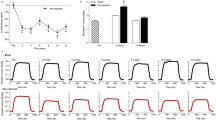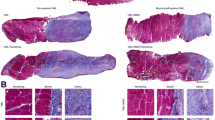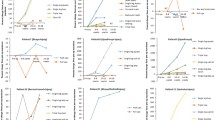Abstract
Background
Complicated tibial fractures with severe soft tissue trauma are challenging to treat. Frequently associated acute compartment syndrome can result in scarring of muscles with impaired function. Several studies have shown a relationship between angiogenesis and more effective muscle regeneration. Vascular endothelial growth factor (VEGF) is associated with angiogenesis but it is not clear whether it would restore muscle force, reduce scarring, and aid in muscle regeneration after acute musculoskeletal trauma.
Questions/purposes
Therefore, we asked whether local application of VEGF (1) restores muscle force, (2) reduces scar tissue formation, and (3) regenerates muscle tissue.
Methods
We generated acute soft tissue trauma with increased compartment pressure in 22 rabbits and shortened the limbs to simulate fracture débridement. In the test group (n = 11), a VEGF-coated collagen matrix was applied locally around the osteotomy site. After 10 days of limb shortening, gradual distraction of 0.5 mm per 12 hours was performed to restore the original length. Muscle force was measured before trauma and on every fifth day after trauma. Forty days after shortening we euthanized the animals and histologically determined the percentage of connective and muscle tissue.
Results
Recovery of preinjury muscle strength was greater in the VEGF group (2.4 N; 73%) when compared with the control (1.8 N; 53%) with less connective and more muscle tissue in the VEGF group. The recovery of force was related to the percentage of connective tissue versus muscle fibers.
Conclusions
Local application of VEGF may improve restoration of muscle force by reducing connective tissue and increasing the relative amount of muscle fibers.
Clinical Relevance
VEGF may be useful to improve skeletal muscle repair by modulating muscle tissue regeneration and fibrosis reduction after acute trauma.


Similar content being viewed by others
References
Arsic N, Zacchigna S, Zentilin L, Ramirez-Correa G, Pattarini L, Salvi A, Sinagra G, Giacca M. Vascular endothelial growth factor stimulates skeletal muscle regeneration in vivo. Mol Ther. 2004;10:844–854.
Ashley Z, Salmons S, Boncompagni S, Protasi F, Russold M, Lanmuller H, Mayr W, Sutherland H, Jarvis JC. Effects of chronic electrical stimulation on long-term denervated muscles of the rabbit hind limb. J Muscle Res Cell Motil. 2007;28:203–217.
Borselli C, Cezar CA, Shvartsman D, Vandenburgh HH, Mooney DJ. The role of multifunctional delivery scaffold in the ability of cultured myoblasts to promote muscle regeneration. Biomaterials. 2011;32:8905–8914.
Borselli C, Storrie H, Benesch-Lee F, Shvartsman D, Cezar C, Lichtman JW, Vandenburgh HH, Mooney DJ. Functional muscle regeneration with combined delivery of angiogenesis and myogenesis factors. Proc Natl Acad Sci USA. 2010;107:3287–3292.
Breen EC, Johnson EC, Wagner H, Tseng HM, Sung LA, Wagner PD. Angiogenic growth factor mRNA responses in muscle to a single bout of exercise. J Appl Physiol. 1996;81:355–361.
Brunelli S, Rovere-Querini P. The immune system and the repair of skeletal muscle. Pharmacol Res. 2008;58:117–121.
Deasy BM, Feduska JM, Payne TR, Li Y, Ambrosio F, Huard J. Effect of VEGF on the regenerative capacity of muscle stem cells in dystrophic skeletal muscle. Mol Ther. 2009;17:1788–1798.
Ferrara N. Role of vascular endothelial growth factor in physiologic and pathologic angiogenesis: therapeutic implications. Semin Oncol. 2002;29(6 suppl 16):10–14.
Ferrara N, Gerber HP, LeCouter J. The biology of VEGF and its receptors. Nat Med. 2003;9:669–676.
Germani A, Di Carlo A, Mangoni A, Straino S, Giacinti C, Turrini P, Biglioli P, Capogrossi MC. Vascular endothelial growth factor modulates skeletal myoblast function. Am J Pathol. 2003;163:1417–1428.
Gustafsson T, Puntschart A, Kaijser L, Jansson E, Sundberg CJ. Exercise-induced expression of angiogenesis-related transcription and growth factors in human skeletal muscle. Am J Physiol. 1999;276:H679–685.
Hill A, Geissler S, Weigandt M, Mader K. Controlled delivery of nanosuspensions from osmotic pumps: zero order and non-zero order kinetics. J Control Release. 2012;158:403–412.
Hudlicka O, Milkiewicz M, Cotter MA, Brown MD. Hypoxia and expression of VEGF-A protein in relation to capillary growth in electrically stimulated rat and rabbit skeletal muscles. Exp Physiol. 2002;87:373–381.
Kivelä R, Silvennoinen M, Lehti M, Jalava S, Vihko V, Kainulainen H. Exercise-induced expression of angiogenic growth factors in skeletal muscle and in capillaries of healthy and diabetic mice. Cardiovasc Diabetol. 2008;7:13.
Kleinheinz J, Jung S, Wermker K, Fischer C, Joos U. Release kinetics of VEGF165 from a collagen matrix and structural matrix changes in a circulation model. Head Face Med. 2010;6:17.
Kliem MA, Heeke BL, Franz CK, Radovitskiy I, Raore B, Barrow E, Snyder BR, Federici T, Kaye Spratt S, Boulis NM. Intramuscular administration of a VEGF zinc finger transcription factor activator (VEGF-ZFP-TF) improves functional outcomes in SOD1 rats. Amyotroph Lateral Scler. 2011;12:331–339.
Levenberg S, Rouwkema J, Macdonald M, Garfein ES, Kohane DS, Darland DC, Marini R, van Blitterswijk CA, Mulligan RC, D’Amore PA, Langer R. Engineering vascularized skeletal muscle tissue. Nat Biotechnol. 2005;23:879–884.
Lim TY, Poh CK, Wang W. Poly (lactic-co-glycolic acid) as a controlled release delivery device. J Mater Sci Mater Med. 2009;20:1669–1675.
Lokmic Z, Darby IA, Thompson EW, Mitchell GM. Time course analysis of hypoxia, granulation tissue and blood vessel growth, and remodeling in healing rat cutaneous incisional primary intention wounds. Wound Repair Regen. 2006;14:277–288.
McQueen MM, Christie J, Court-Brown CM. Acute compartment syndrome in tibial diaphyseal fractures. J Bone Joint Surg Br. 1996;78:95–98.
Meffert RH, Frey SP, Jansen H, Ochman S, Raschke MJ, Langer M. Muscle strength quantification in small animals: a new transcutaneous technique in rabbits. J Orthop Res. 2008;26:1526–1532.
Meffert RH, Jansen H, Frey SP, Raschke MJ, Langer M. The influence of soft tissue trauma on bone regeneration after acute limb shortening. Clin Orthop Relat Res. 2007;460:202–209.
Messina S, Mazzeo A, Bitto A, Aguennouz M, Migliorato A, De Pasquale MG, Minutoli L, Altavilla D, Zentilin L, Giacca M, Squadrito F, Vita G. VEGF overexpression via adeno-associated virus gene transfer promotes skeletal muscle regeneration and enhances muscle function in mdx mice. FASEB J. 2007;21:3737–3746.
Mollenhoff G, Josten C, Muhr G. [Callotaxis: osteogenesis by stretching–a conservative possibility for restoring leg length after post-traumatic primary tibial shortening?][in German]. Zentralbl Chir. 1997;122:970–973.
Ochman S, Frey S, Raschke MJ, Deventer JN, Meffert RH. Local application of VEGF compensates callus deficiency after acute soft tissue trauma: results using a limb-shortening distraction procedure in rabbit tibia. J Orthop Res. 2011;29:1093–1098.
Oshima H, Payne TR, Urish KL, Sakai T, Ling Y, Gharaibeh B, Tobita K, Keller BB, Cummins JH, Huard J. Differential myocardial infarct repair with muscle stem cells compared to myoblasts. Mol Ther. 2005;12:1130–1141.
Qu-Petersen Z, Deasy B, Jankowski R, Ikezawa M, Cummins J, Pruchnic R, Mytinger J, Cao B, Gates C, Wernig A, Huard J. Identification of a novel population of muscle stem cells in mice: potential for muscle regeneration. J Cell Biol. 2002;157:851–864.
Rissanen TT, Vajanto I, Hiltunen MO, Rutanen J, Kettunen MI, Niemi M, Leppanen P, Turunen MP, Markkanen JE, Arve K, Alhava E, Kauppinen RA, Yla-Herttuala S. Expression of vascular endothelial growth factor and vascular endothelial growth factor receptor-2 (KDR/Flk-1) in ischemic skeletal muscle and its regeneration. Am J Pathol. 2002;160:1393–1403.
Sacramento CB, da Silva FH, Nardi NB, Yasumura EG, Baptista-Silva JC, Beutel A, de Campos RR, de Moraes JZ, Junior HS, Samoto VY, Borojevic R, Han SW. Synergistic effect of vascular endothelial growth factor and granulocyte colony-stimulating factor double gene therapy in mouse limb ischemia. J Gene Med. 2010;12:310–319.
Schmidt-Bleek K, Schell H, Kolar P, Pfaff M, Perka C, Buttgereit F, Duda G, Lienau J. Cellular composition of the initial fracture hematoma compared to a muscle hematoma: a study in sheep. J Orthop Res. 2009;27:1147–1151.
Tang K, Breen EC, Wagner H, Brutsaert TD, Gassmann M, Wagner PD. HIF and VEGF relationships in response to hypoxia and sciatic nerve stimulation in rat gastrocnemius. Respir Physiol Neurobiol. 2004;144:71–80.
Yang F, Cho SW, Son SM, Bogatyrev SR, Singh D, Green JJ, Mei Y, Park S, Bhang SH, Kim BS, Langer R, Anderson DG. Genetic engineering of human stem cells for enhanced angiogenesis using biodegradable polymeric nanoparticles. Proc Natl Acad Sci USA. 2010;107:3317–3322.
Yasumura EG, Stilhano RS, Samoto VY, Matsumoto PK, de Carvalho LP, Valero Lapchik VB, Han SW. Treatment of mouse limb ischemia with an integrative hypoxia-responsive vector expressing the vascular endothelial growth factor gene. PLoS One. 2012;7:e33944.
Acknowledgments
We thank Karim Gorschlueter MD, former medical student at the University of Muenster, for assistance with the muscle force measurements and histologic and histomorphometric analyses, Torsten Blunk PhD for his support discussing the results, James Ridgley MD for critically reviewing the manuscript as a native speaker, and Daniela Keller Dipl. Math.-statistics for her excellent support.
Author information
Authors and Affiliations
Corresponding author
Additional information
One of the authors certifies that he (SPF) has or may receive payments or benefits, during the study period, an amount less than $10,000, from IZKF Wuerzburg (Interdisziplinäres Zentrum für Klinische Forschung), University of Wuerzburg, Wuerzburg, Germany.
One of the authors (SO) has or may receive payments or benefits, during the study period, an amount less than $10,000, from IMF (Innovative Medizinische Forschung), University of Muenster, Muenster, Germany.
All ICMJE Conflict of Interest Forms for authors and Clinical Orthopaedics and Related Research editors and board members are on file with the publication and can be viewed on request.
Each author certifies that his or her institution approved the animal protocol for this investigation and that all investigations were conducted in conformity with ethical principles of research.
This work was performed at the University of Wuerzburg, Wuerzburg, Germany, and the University of Muenster, Muenster, Germany, in equal parts.
About this article
Cite this article
Frey, S.P., Jansen, H., Raschke, M.J. et al. VEGF Improves Skeletal Muscle Regeneration After Acute Trauma and Reconstruction of the Limb in a Rabbit Model. Clin Orthop Relat Res 470, 3607–3614 (2012). https://doi.org/10.1007/s11999-012-2456-7
Received:
Accepted:
Published:
Issue Date:
DOI: https://doi.org/10.1007/s11999-012-2456-7




